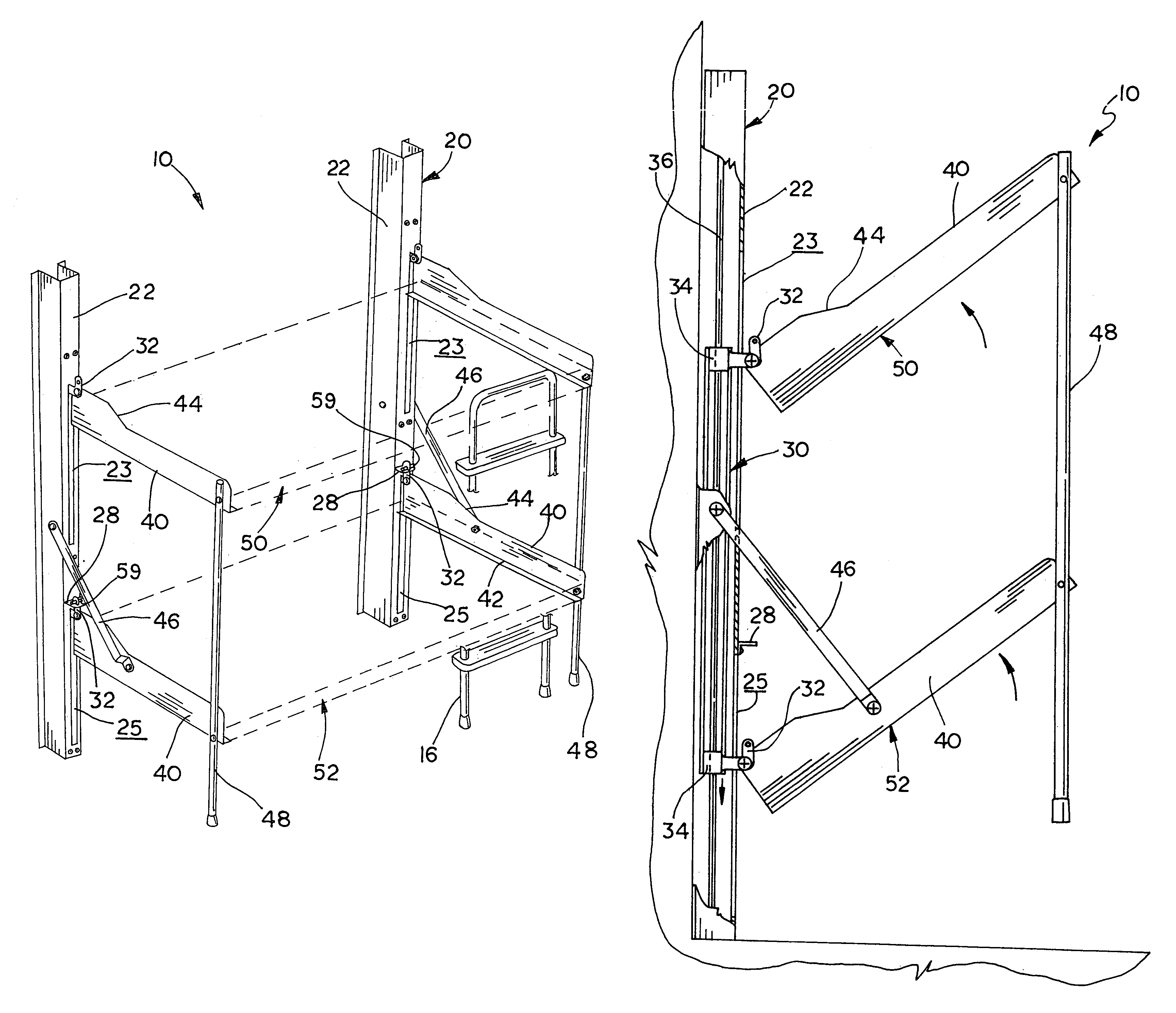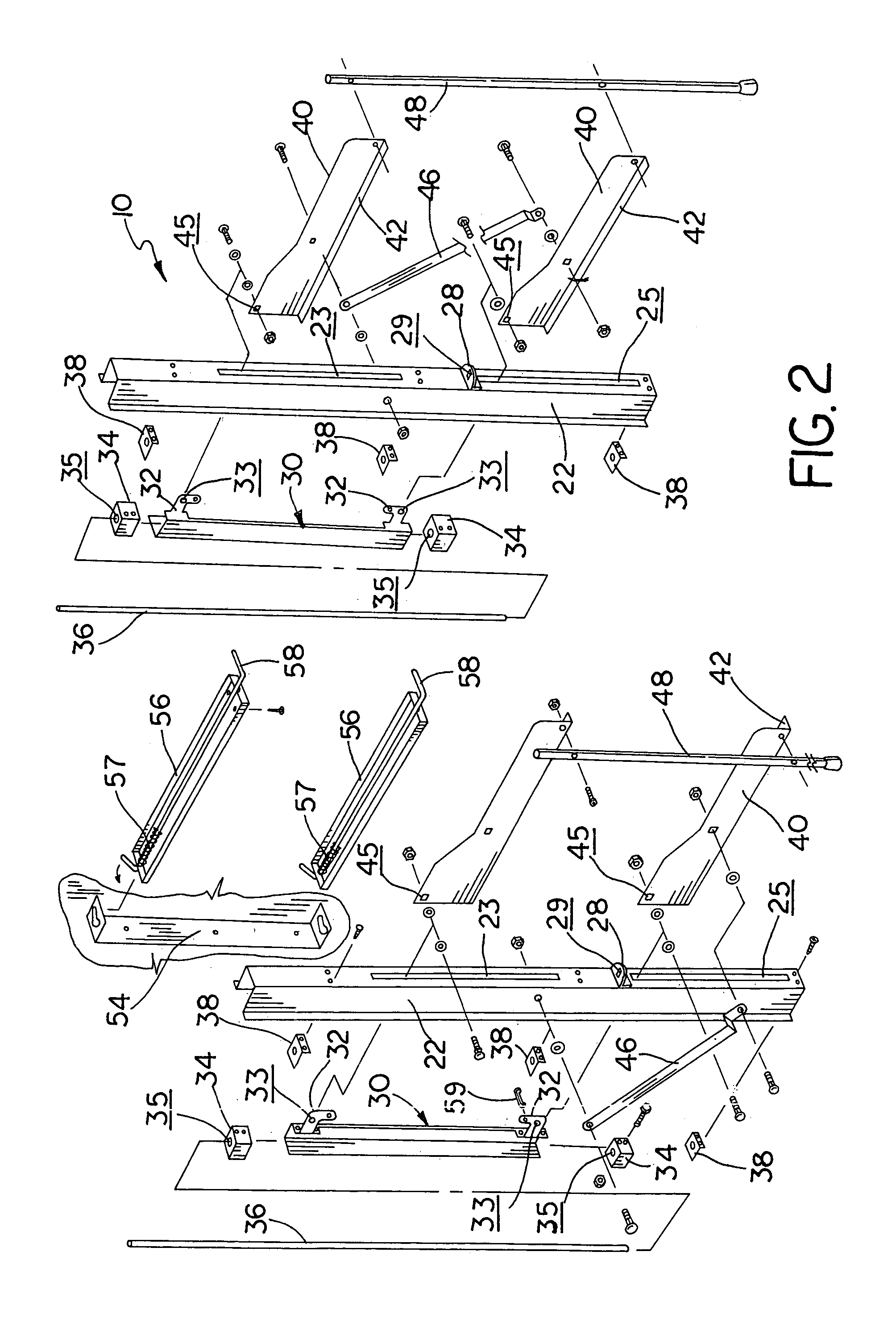Folding bunk bed
a bunk bed and folding technology, applied in the field of folding bunk beds, can solve the problems of reducing the operation of cable-actuated folding bunk beds, limiting the bed deck to twin beds,
- Summary
- Abstract
- Description
- Claims
- Application Information
AI Technical Summary
Benefits of technology
Problems solved by technology
Method used
Image
Examples
first embodiment
Bunk Bed
[0035]FIGS. 1–7 illustrate the first manually operated embodiment of the bunk bed of this invention, which is designated generally as reference numeral 10. Bunk bed 10 includes a wall frame 20, which is secured to a vertical wall, a pair of carriages 30 shiftably mounted on shafts 36 vertically disposed within the wall frame, and a pair of bed decks (upper deck 50 and lower deck 52) pivotally connected to the carriages.
[0036]Wall frame 20 secures bunk bed 10 to the interior walls of a structure or vehicle and provide the structural supports for the bunk bed. Wall frame 20 is mountable to an interior wall of a house or recreational vehicle (not shown) using screws, bolts, adhesive or other suitable methods well known in the arts. Wall frame 20 includes a pair of uprights 22, which are constructed of a section of metal U-channel. As shown, each upright 22 has two elongated longitudinal slots (upper 23 and lower 25). A long shaft 36 is vertically disposed within each upright 22...
second embodiment
erlapping Bunk Bed
[0040]FIGS. 8 and 9 illustrate a second embodiment of the manually folding bunk bed of this invention, which is designated generally as numeral 60. Bunk bed 60 is similar in construction and operation to bunk bed 10 above, except that the lower bed deck 62 is significantly larger and folds to overlie the upper bed deck 64. As shown, the lower deck support arm 66 has a greater depth, which spaces the deck further from the wall frame to allow the lower deck to overlie the upper deck. Bunk bed 60 also includes separate bed posts 68 to connect the bed decks and post feet 69 to support the decks.
third embodiment
nk Bed with Linkage
[0041]FIGS. 10–14 illustrate a third embodiment of the folding bunk bed assembly of this invention, which is designated generally as reference numeral 10. Bunk bed 70 is a powered version of the first embodiment of the folding bunk bed of this invention. Bunk bed 70 is substantially similar to bunk bed 10 in design, construction and operation, except that it includes a powered actuation mechanism supported and enclosed within the wall frame. The powered actuation mechanism eliminates the carriage so that the bed decks are hinged directly to bearing blocks that travel along a pair of screw shafts. Again, a linkage is connected between the support arms of one bed deck and the upright of the wall frame and bed posts are used to support the bed decks in the sleep position.
[0042]The actuation mechanism includes an electric motor 72, a coupler 73, two gear boxes 74, a drive axle 75, a pair of screw shafts 76 and two pairs of bearing blocks 78. Ideally, motor 72 is a con...
PUM
 Login to View More
Login to View More Abstract
Description
Claims
Application Information
 Login to View More
Login to View More - R&D
- Intellectual Property
- Life Sciences
- Materials
- Tech Scout
- Unparalleled Data Quality
- Higher Quality Content
- 60% Fewer Hallucinations
Browse by: Latest US Patents, China's latest patents, Technical Efficacy Thesaurus, Application Domain, Technology Topic, Popular Technical Reports.
© 2025 PatSnap. All rights reserved.Legal|Privacy policy|Modern Slavery Act Transparency Statement|Sitemap|About US| Contact US: help@patsnap.com



